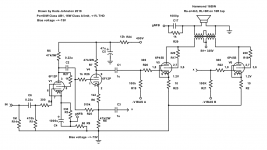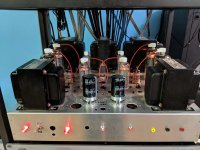A good idea to add switch that switches output transformers, B+, G2, and bias voltages, for optimal Triode/UL/Pentode operations!
Otherwise it is a hoax, even though a fashionable one...
makes me wish OPT's have pin sockets that can be plugged in and out of an amp.....OPT rolling anyone?
Good point. The last time I did a switch the thing was biased by cathode resistors, the bias lined up by itself basically. And I'm sure no one has UL curves for the 6P45S because most people on here dislike UL  I just figured if the taps are there I could try it out and see what it was like anyway.
I just figured if the taps are there I could try it out and see what it was like anyway.
I found this on a Polish forum. Seems he's tried UL and likes Pentode more.
http://www.forum-trioda.pl/viewtopic.php?t=1326
http://www.forum-trioda.pl/viewtopic.php?t=1326
OK. So I just noticed that on loud attacks like a bass drum kick or a snare, there is a DC wobble on the speaker. The same circuit (save for OPTs) when powered by SMPS doesn't do this. Am I correct in thinking this is just a variation in B+ showing as output on the speaker? Obviously SMPS is much stiffer than a tube/choke circuit.
OK. So I just noticed that on loud attacks like a bass drum kick or a snare, there is a DC wobble on the speaker. The same circuit (save for OPTs) when powered by SMPS doesn't do this. Am I correct in thinking this is just a variation in B+ showing as output on the speaker? Obviously SMPS is much stiffer than a tube/choke circuit.
nowadays, you can get 1000ufd/450volt caps for filtering very cheap...
i use a lot of filtering in my tube amps....
smps operating at the higher frequencies can react faster than linear psu's...
Updates...
Ok. So I tried did some more testing and noticed a 850kHz oscillation. Changing the pentode input to triode mode killed it.
I also doubled up on the 6D22S tubes for better longevity, and higher B+.
I raised the overall B+ by using the 115V primary tap instead of the 125V...
I rewired the OPT for 16R secondary, 8R load... Approx 2k2 Ra-a now, with a resulting boost in output power to 60W.
Included is the updated and latest schematic.
Ok. So I tried did some more testing and noticed a 850kHz oscillation. Changing the pentode input to triode mode killed it.
I also doubled up on the 6D22S tubes for better longevity, and higher B+.
I raised the overall B+ by using the 115V primary tap instead of the 125V...
I rewired the OPT for 16R secondary, 8R load... Approx 2k2 Ra-a now, with a resulting boost in output power to 60W.
Included is the updated and latest schematic.
Attachments
nowadays, you can get 1000ufd/450volt caps for filtering very cheap...
i use a lot of filtering in my tube amps....
smps operating at the higher frequencies can react faster than linear psu's...
I know
Did the changes you made make the woofer wobble go away?
I don't think a snare drum would do it, but a kick drum has enough unidirectional excursion on the first impulse to cause a woofer to go beyond its linear range (in one direction). The exponential decay makes the excursion in the other direction be less.
It takes real time for the woofer to reset (not just go the other direction, but come to where it follows so that zero crossing of the signal voltage is also the center of the woofer springs).
Think of an over excursion in only one direction as causing an effect similar to a temporary DC bias shift.
I don't think a snare drum would do it, but a kick drum has enough unidirectional excursion on the first impulse to cause a woofer to go beyond its linear range (in one direction). The exponential decay makes the excursion in the other direction be less.
It takes real time for the woofer to reset (not just go the other direction, but come to where it follows so that zero crossing of the signal voltage is also the center of the woofer springs).
Think of an over excursion in only one direction as causing an effect similar to a temporary DC bias shift.
It's still there but reduced on a square (I think?) because of the change in the Ra-a. Since the speaker systems are both more powerful than this amplifier, I say it's the amp, not the speaker. They don't do that on the same circuit powered from SMPS with more capacitance (3300uF in that case) and they REALLY don't do any of that off of the 300WPC Yorkville AP1200 either  It's not a bother though, and I don't even notice it on my Energy RC-70, but the RC-22 is almost like a free air system at that frequency so I see it. I'm surprised just how low of a frequency you can pass through a transformer!
It's not a bother though, and I don't even notice it on my Energy RC-70, but the RC-22 is almost like a free air system at that frequency so I see it. I'm surprised just how low of a frequency you can pass through a transformer!
Mostly the changes result in a "stiffer" supply since there are twice the diodes now (OK, definitely). This damned amplifier has more rectifier tubes (7) than amplifying tubes (6)!! No wonder people including me see the merit in solid state diodes Still though, this is quite an amazing result for pre solid state parts. To think I could have built this or something like it in the 50's... Even the 30's with a few design changes...
Still though, this is quite an amazing result for pre solid state parts. To think I could have built this or something like it in the 50's... Even the 30's with a few design changes...
I was one of those kids who thought the whole world was black and white in the 20's because they hadn't invented colour yet (Hey I was a little kid, come on). They tech was up to snuff though, it just would have cost a fortune to build back then.
Mostly the changes result in a "stiffer" supply since there are twice the diodes now (OK, definitely). This damned amplifier has more rectifier tubes (7) than amplifying tubes (6)!! No wonder people including me see the merit in solid state diodes
I was one of those kids who thought the whole world was black and white in the 20's because they hadn't invented colour yet (Hey I was a little kid, come on). They tech was up to snuff though, it just would have cost a fortune to build back then.
Last edited:
Ok. So I tried did some more testing and noticed a 850kHz oscillation. Changing the pentode input to triode mode killed it.
You should try instead a 33pf-120pf cap between grid and ground instead of a grid stopping resistor.
Interesting. I'll try that. But doesn't the grid leak need a DC path to ground? I've actually wired it in such a way that if I wanted to, I could use a switch to go from triode to pentode on the 6F12P. In reality, I think it's the fact that the gNFB network didn't change, but the OPT did (because of 2k2 vs 4k3).
Another test: It takes 415W from the wall. Power Factor 0.9. I now call this the "Winter Amplifier / Amplificateur D'hiver" People with cheap electricity in Québec know what I mean...
People with cheap electricity in Québec know what I mean...
Here's a shot of the improved build. Those who are savvy will notice that the capacitors are fake. I couldn't find this value on the UCC sheets for KMH. Still though, the amp is silent in this environment, and the fake caps work.
Indeed, the quartz clock ticking on the wall is louder than the amp with my ear in at the speaker...
I've also designed it so that the 10R sense resistors for bias will fail open like a fuse with excessive current flow like a bias failure.
Another test: It takes 415W from the wall. Power Factor 0.9. I now call this the "Winter Amplifier / Amplificateur D'hiver"
Here's a shot of the improved build. Those who are savvy will notice that the capacitors are fake. I couldn't find this value on the UCC sheets for KMH. Still though, the amp is silent in this environment, and the fake caps work.
Indeed, the quartz clock ticking on the wall is louder than the amp with my ear in at the speaker...
I've also designed it so that the 10R sense resistors for bias will fail open like a fuse with excessive current flow like a bias failure.
Attachments
Interesting. I'll try that. But doesn't the grid leak need a DC path to ground?
Yes, a grid leak does need the path to the ground. But when you apply a negative feedback to the cathode, you need also a path for it, from grid to ground, on AC. A grid stopper contradicts that.
820uF at 335V has the same charge as 3300uF at 83V.
No; charge energy is F times *square* of voltage.
6A3sUMMER wrote;
don't think a snare drum would do it, but a kick drum has enough unidirectional excursion on the first impulse to cause a woofer to go beyond its linear range (in one direction). The exponential decay makes the excursion in the other direction be less.
It takes real time for the woofer to reset (not just go the other direction, but come to where it follows so that zero crossing of the signal voltage is also the center of the woofer springs).
I read on {DIY} thread on this site only horns can reproduce a kick Drum
don't think a snare drum would do it, but a kick drum has enough unidirectional excursion on the first impulse to cause a woofer to go beyond its linear range (in one direction). The exponential decay makes the excursion in the other direction be less.
It takes real time for the woofer to reset (not just go the other direction, but come to where it follows so that zero crossing of the signal voltage is also the center of the woofer springs).
I read on {DIY} thread on this site only horns can reproduce a kick Drum
- Status
- This old topic is closed. If you want to reopen this topic, contact a moderator using the "Report Post" button.
- Home
- Amplifiers
- Tubes / Valves
- New rebuild - 6F12P-6P45S Triode

